8 Best Tips for Business Proposal Presentations [+Examples]
Updated: May 24, 2022
Published: October 18, 2014
Business proposal presentations are the culmination of a long sales process between you and your clients. If you don’t structure it correctly or take the time to craft one with care, you risk losing the client’s buy-in for your solution. So getting it right is essential.

In this article, we’ll look at several ways to improve your business proposal presentation (and pitch) and increase the odds that you’ll walk away with a new customer.


Business Proposal Presentation
A business proposal presentation is a document that outlines a business solution for a customer after a lengthy consultation process. It is presented to the customer in either PDF or PowerPoint format, and can be paired with a contract for immediate signing.
Other formats that may be accepted include Google Docs or Google Slides, but PowerPoint is the industry standard. The presentation is then delivered in person or through a video conferencing tool such as Zoom.
Rarely, if ever, is a business proposal presentation sent to the customer for asynchronous perusal. Rather, it’s presented live in a customer meeting . That will give you the opportunity to sell them even more on the solutions you offer and persuade them to make a decision within a reasonable time frame.
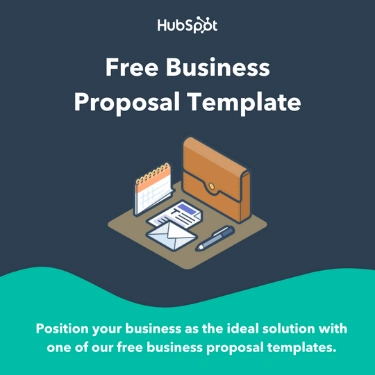
Free Business Proposal Template
Propose your business as the ideal solution using our Free Business Proposal Templates
- Problem summary
- Proposed solution
- Pricing information
- Project timeline
Download Free
All fields are required.
You're all set!
Click this link to access this resource at any time.
If you let the customer review the presentation on their own, it’s likely that they’ll lengthen the sales process and even put off making a decision.
When crafting your proposal presentation, there are a few quick best practices to keep in mind.
- Personalize the presentation . While it’s totally fine to reuse a PowerPoint presentation template , you don’t want to accidentally include another business’ name on the deck. So be sure to go through every slide and personalize it for the customer’s goals and pain points.
- Send a pre-meeting email with an agenda. To prepare your customer for the presentation, it’d be wise to send a pre-meeting email with a quick, scannable sales agenda detailing how the meeting will go. That way, you can set the right expectations and keep you both on track.
- Plan your in-person customer visit. If you’re meeting the customer in person, there will be a few more elements at play, such as an office tour and even a colleague introduction. That can quickly lead to lost time, so use this guide to plan a customer visit that stays on track and helps you effectively sell your solution.
- Pay attention to the design of the deck . Your clothes and demeanor may be in tip-top shape, but if your deck is messy and poorly designed, then the effectiveness of your points will be diminished. Use a PowerPoint template and check out a few sales presentation examples to inspire you.
- Keep the presentation short and precise. Keep your presentation as short as possible, about 15 to 20 minutes. The longer you speak to your clients, the less they’ll remember.
Now, it’s time for your presentation. Let’s go over how you can execute it flawlessly.
How to Present a Business Proposal
- Optimize your meeting time from the start.
- Have a clear agenda.
- Open up with the customer’s problems and challenges.
- Pause and ask questions.
- Lead with stories, not data.
- Don’t read off of your PowerPoint slides.
- Present your solution — and sell them a vision.
- Establish a clear follow-up timeline at the end of the meeting.
1. Optimize your meeting time from the start.
When presenting a proposal, it’s important to remember that your clients are busy. They have other meetings to attend, phone calls and emails to return, and problems to solve. Time is their most precious asset. Here are a few tips to optimize the time you spend with your customers:
- Arrive early . This is a no-brainer, but arrive to the meeting with at least ten minutes to spare, especially if it’s in person. Use this buffer to use the bathroom, rehearse your introduction, and even set up the meeting space.
- Rehearse setting up the projector or sharing your screen before the meeting . If you’re carrying out a meeting in person, you don’t want to waste ten minutes figuring out how to project your laptop’s screen. Carry several adapters with you and have a fail-safe plan, such as bringing a tablet with a copy of the presentation. If the meeting is over Zoom, practice sharing your screen so that your notes aren’t visible.
- Keep your introduction short. Leave space for banter and rapport, but keep your personal introduction short. Small talk should be reduced as much as possible — you shouldn’t spend twenty minutes talking about the weather, unless you sell a weather-related solution.
2. Have a clear agenda.
Your presentation must have a clear and compelling agenda, which you can share right at the start (in addition to having shared it over email before the meeting).
The meeting should begin with compelling reasons to consider your proposal and culminate with a specific request for the business. Here’s an agenda template you can use to structure your meeting:
- Challenge/Opportunity. Begin your presentation by illustrating the opportunity or challenge that your client is overlooking. Make sure it’s compelling enough to motivate your client to listen to the rest of your presentation.
- Benefits . Discuss the benefits that your client will achieve by adopting your solution. Use a customer case study or testimonial to support your point.
- Plan . Present your plan or options to resolve the client’s challenge/opportunity.
- Company . Briefly share your company’s background, including who your company helps with these issues.
- Recommend . Before closing your presentation, be sure to ask for the client’s business. You might close by asking the client, “Do you believe that the solution that I’ve presented will effectively help you overcome your challenges and achieve your goals?”
In the presentation, include a few bullet points that outline these parts of the meeting, so that the client knows what to expect.
3. Open up with the customer’s problems and challenges.
As mentioned, you’ll begin the meeting with a challenge or opportunity. Don’t walk into the meeting and immediately start talking about yourself or your company or your products. If you do this, your client will immediately focus on cost and product features, often ending the meeting before you’ve had a chance to finish.
Instead, focus on re-emphasizing the customer’s challenges and pain points. Your clients want to know how they can beat their competitors, reach new customers, retain existing customers, and increase profit margins. But before you can sell them your product, you have to emphasize the graveness of the issue they’re facing and illustrate how their challenges will prevent them from achieving these goals.
For instance, if 30% of their customers are churning, and you sell a business solution that can help reduce churn, you might open up your presentation with how their revenue will continue to be impacted by this loss. This will emphasize the urgency of the problem and help you create a stronger pitch later.
4. Pause and ask questions.
After you’ve spoken for a few minutes, stop and ask your client a question. This is a great way to stay in control of the meeting while allowing your client to interact with the sales presentation.
Here are some questions that you might ask:
- Have I summarized your challenges correctly?
- Is there anything I’ve missed that you’d like to add?
- Am I right in saying that you want to solve this problem in the next quarter?
5. Lead with stories, not data.
While clients value data, they are also realistic about what data can — and cannot — tell them. They’ve seen many projects fail despite the glowing research results, and they’ve seen projects succeed despite the lack of any data to back it up.
So, introduce stories first, then the data to back it up. Come to the presentation armed with customer experiences and competitor moves. Your clients are far more interested in what other businesses like them have experienced and what their competitors are doing. They’re not all that interested in the latest research study, but you can use a study to support your points and lend credence to an anecdote.
6. Don’t read off of your PowerPoint slides.
Let the deck complement your points. If you read directly off the slides, you’ll quickly bore your customer, and the impact of what you’re saying won’t land.
Keep your slides simple, too, so that you’re not tempted to read off of them. Most slides are far too complex — too much text, distracting designs, and unrelated images.
You should only put one picture and one line of text on a slide. No more. Your clients can only absorb so much at once, and if they’re too busy trying to sort out paragraphs upon paragraphs on the screen, most of what you’ll say will be missed.
7. Present your solution — and sell them a vision.
After you’ve re-established the business challenge and spoken to the customer’s pain points, it’s time to present your product or service as a solution. But it’s important to not stop here — you have to also sell them a vision of what their business will look like after they take care of the problem.
Will they experience increased sales? Streamlined processes? Better customer retention? And what will that look like a few years from now? Don’t exaggerate, but don’t be afraid to show them how your product can create a much positive future for their business.
8. Establish a clear follow-up timeline at the end of the meeting.
This is maybe the most important part of your business proposal presentation. Tell your customer what will happen after the presentation, so that there’s no ambiguity regarding next steps.
We highly recommend establishing a clear follow-up date. Don’t say, “I’ll follow up in about a week.” Instead, try, “Is it okay if I call you on Friday, May 10th?”
We also recommend creating a timeline after the follow-up call. For instance, you might say you’ll call on a certain date, and then you’ll send the contract over using a tool such as PandaDoc , Qwilr , or Proposify . Your contract will be in your customer’s hand for a week, and then on the following Wednesday, you’ll follow-up once again to see if the customer has any questions.
Adjust this timeline depending on your customer, sales cycle length , and industry. Such a short timeline might not suit a product that costs thousands of dollars and requires a yearly commitment. However, it might suit a product that only costs a few hundred dollars a year.
Feeling stumped? No worries. Below, we share some business proposal examples you can glean inspiration from.
Business Proposal Presentation Examples
1. moving malta forward.

This compelling presentation proposes a metro system for the city of Malta. It opens with a “Case for Change” and uses graphics and visuals to argue for the creation of a metro in the city. While it is text heavy, it includes plenty of information for Malta’s government to make a decision. That’s why it’s important to know your audience. If you’re proposing to a gubernatorial entity, then being comprehensive is important.
2. The Big Picture

This is another presentation that argues for the urban development of a district. Its most notable feature is its “At a glance” spread, which shows an overview of the plan from top to bottom, down to the impact the proposed changes will have on the city. In the same way, you can include at an at-a-glance slide in your presentation.
3. AMW Tech

This deck presents a business as opposed to a product, but it does everything right: It opens with an agenda and closes with a call-to-action (“Keep in touch with us”). Even something as simple as providing your contact information can be enough to prompt your customer to continue the conversation.
4. Microsoft Advertising

This deck by Microsoft Advertising takes a slightly different approach: It starts with a quote from the Microsoft CEO, and then provides details about how the brand helps its customers. This works for a major brand like this one because the client may be interested in Microsoft as a whole as opposed to just one service. It’s important to know your audience in this respect, as well.
Creating a Compelling Business Proposal Presentation
Being able to effectively present proposals is key to your success. To be effective, get to the point and focus on vision and stories. Use PowerPoint or Keynote as supporting material and be sure to keep it short. Finally, your presentation should begin with compelling reasons to consider your proposal and culminate with a specific request for the business.
Editor's note: This post was originally published in July 2014 and has been updated for comprehensiveness.
Don't forget to share this post!
Related articles.
![how to make a good proposal presentation What is a Marketing Proposal, and How Can You Create One? [Template Included]](https://www.hubspot.com/hubfs/marketing%20proposals-1.jpg)
What is a Marketing Proposal, and How Can You Create One? [Template Included]

The RFP Response Formula That Gets an 80% Close Rate

15 Proposal Software Tools for Proposal Creation and Management

7 Things to Consider Before Issuing Your Next RFP

How to Get Paid for Proposals

Why RFPs Fail When Choosing a Marketing Agency

Should You Respond to That RFP? 4 Reasons For Saying 'Yes'

4 Tips For Presenting Powerful New Business Proposals
![how to make a good proposal presentation Bidsketch Gives Agencies the Tools to Create Proposals — Fast [Tech Profile]](https://cdn2.hubspot.net/hub/53/file-1520221479-jpg/blog-files/ruben.jpg)
Bidsketch Gives Agencies the Tools to Create Proposals — Fast [Tech Profile]

5 Things Every Marketer Needs to Include in a RFP
Propose your business as the ideal solution using this free template.
Marketing software that helps you drive revenue, save time and resources, and measure and optimize your investments — all on one easy-to-use platform
Home Blog Business How to Write a Project Proposal and Present it to Stakeholders
How to Write a Project Proposal and Present it to Stakeholders
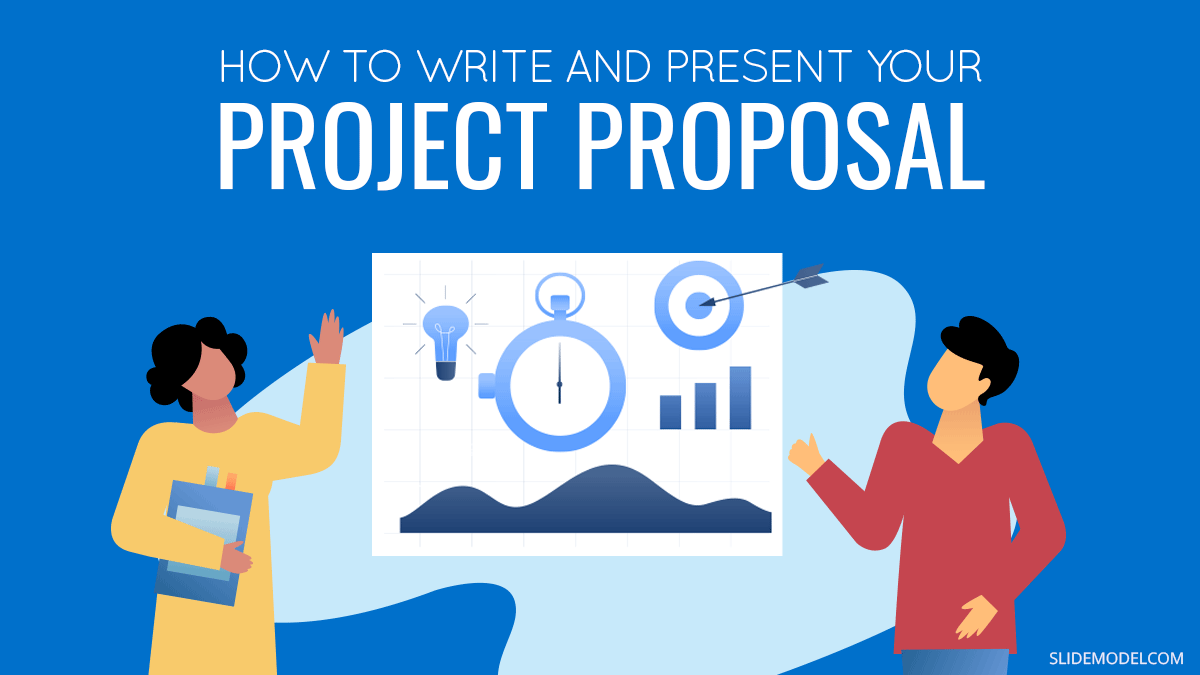
Every manager or executive has at some point of their career the need to create a project proposal (or initiative, we will use both terms instinctively in this post). In this opportunity we will briefly define the concept, how to write it and more importantly how to present it to an audience. Persuasion is key. Being able to transmit the right message behind the proposal will help you engage your audience with your ideas.
What Is a Project Proposal?
A project proposal is a document that details a new project idea. Its main objective is to communicate the idea, and what is needed to make it happen. In its most basic form, it contains a title, initial and end dates, objectives, goals and the overall main achievement pursued at completion of the project.
Formal project proposals have clear sections that have been proven to effectively communicate a project idea. The basics include context about the problem or pain trying to solve, a high level action plan, and the required resources to execute it. We’ll give you more detail into how to write project proposal categories later on in this article.
Note that a business project proposal is not the same thing as a complete project plan , in terms of project management . The project proposal includes a lot of details in many of the same categories as a project charter or a complete project plan. However, it is not the same document. The project proposal is not a detailed execution plan. There are lots of details that may change between the proposal presentation and the final, approved project plan.
Types of Project Proposals
There are many different kinds of project proposals, since there are many different kinds of projects. For the sake of keeping the article with a reasonable length, we will exemplify Business Project Proposals.
Business project proposals range from formal to informal and vary greatly depending on the industry and company where they are defined. This article focuses on business project proposals, though a lot of the basics and recommendations also apply to different categories.
Situations that Require to Write a Business Project Proposal
Projects intake vary depending on the management frameworks applied by every organization. But there are common management practices that trigger the need for project proposals.
The most common place for project definitions and ideation is during Corporate Planning. Independently of the size of the organization, planning is a practice that every professional organization carries out. Could be defined as Corporate Planning, or just Growth planning, but the time of the year where executives prepare their forecast and plan for the future is the main event where initiatives are defined. In order to evaluate them objectively, project proposals are created. Based on the proposals, the executives decide which projects they will sponsor. With this in mind, it is important that the document is formal, informative, but also persuasive.
How to Write a Project Proposal
The following paragraphs describe the common sections of a professional project proposal document. Keep in mind that this guide does not pretend to be exhaustive and is understood that you’ll need to evaluate adjustments to this outline in order to make it work for your industry, field, and department.
Step One: Define the Purpose around a Problem or Pain
No executive team will approve or fund a project if it’s not solving a realistic problem, situation. While it may sound negative, in business a lot of decisions are made around addressing pains, both organizational and client-facing. This step aims to show stakeholders why your project is important and what are the stakes if they don’t approve it.
Since your problem statement is the very first section of your project proposal, it has to be strong. If you don’t make your audience start believing in the need for a new initiative at this point, it will be very hard to change their minds later on. Don’t exaggerate the problem, since that is easy to discover later on, but be emphatic about why this is a problem that needs fixing. Backup your claims with facts, figures, and business cases. The cost of “ not doing ” is also a strong argument.
Here are some questions to consider when defining the problem:
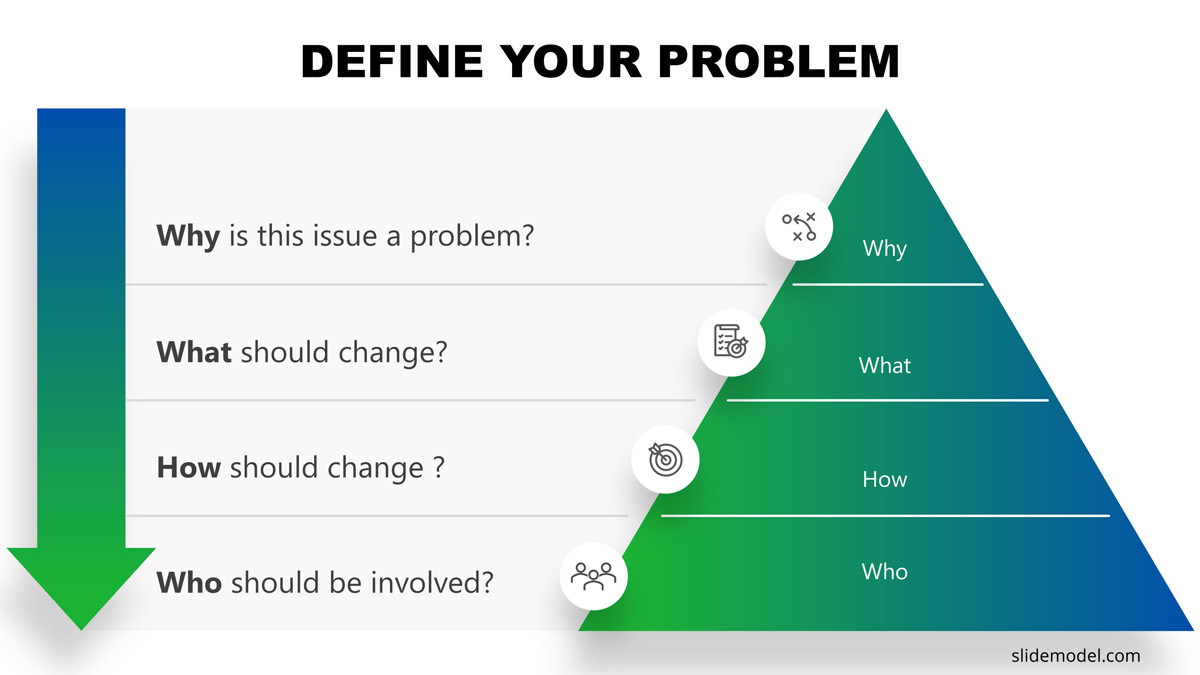
Step Two: Introduce The Solution
Now that you’ve hopefully convinced your audience of the existence of a problem, you now have to introduce the proposed solution. The next several steps will help you specify some of the more tangible components of the “how”. On this step, however, you’re still at the dazzling and inspiring stage.
That means your introduction to the plan should focus on its benefits.
How is this going to address the problem and what is your organization going to get out of it? Think increased profits, lowered costs, new products on the market, more satisfied clients, increased brand awareness, etc.
What is the anticipated impact of your project or idea? Focus on wide-ranging effects for a more impressive presentation.
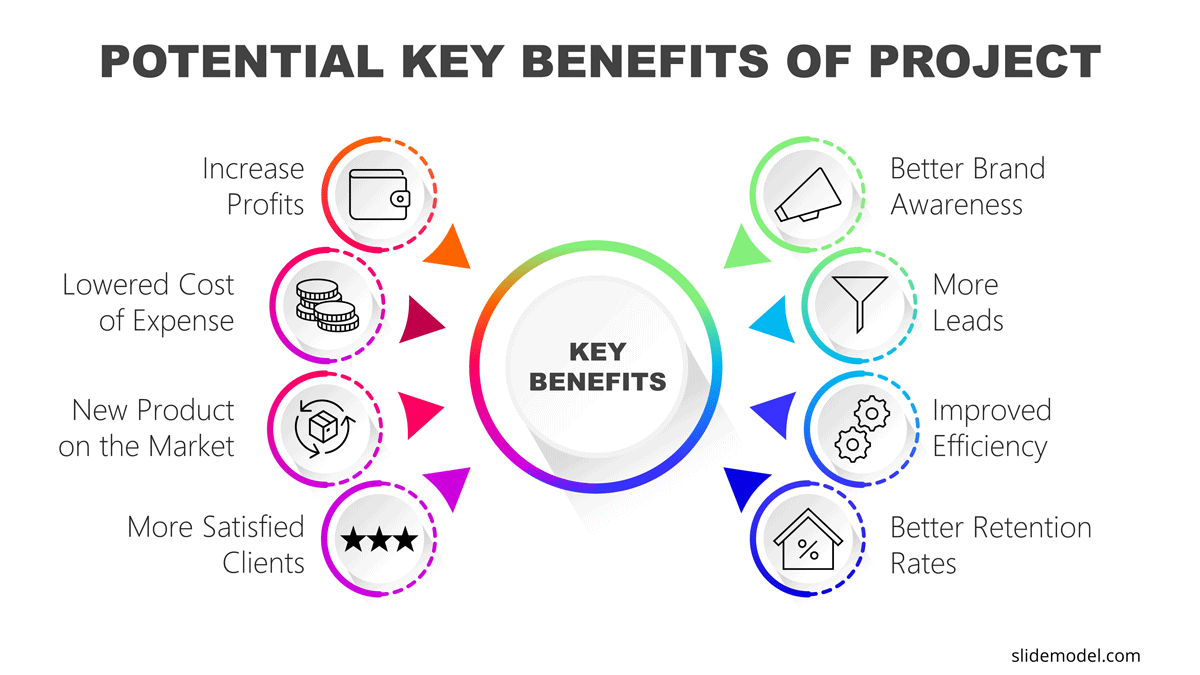
Step Three: Specify Deliverables and Success Criteria
Deliverables are the results of your project. Think about it as the components, both tangible and intangible, that you’ll be delivering. Include the functions and characteristics of each deliverable, such as what it will do, how it will work, and what benefit it will have. Include details such as due date and key tasks required to successfully carry out each deliverable.
Alongside the definition of deliverables are the success criteria. It’s important to specify how you’ll know if each deliverable has been successfully created, as well as the project as a whole. Whenever you’re presenting objectives or criteria for evaluating success, use the SMART goals approach. SMART stands for specific, measurable, achievable, realistic, and time-bound. You can try using a roadmap template to visualize these deliverables and delivery dates.
Step Four: Outline Project Resources
In order to execute a project, you will require resources. Generally in a project proposal you will divide this definition in two. First, an overall estimation of resources in a common language , financial . So you will translate every resource into budgeting terms and define an investment number. Then, you will break down these financials into: assets (i.e.: technology, infrastructure), human resources, services (i.e.: advertisement, consultancy).
Step Five: Outline your Schedule
In this section you will combine deliverables and resources to generate a high level roadmap. Main points to highlight are start and end of the project, delivery dates and resources usage times. In this way you will materialize the proposal in high level activities.
Step Six: Executive Summary
Once the detailed version of your project proposal is complete, it’s time to summarize the presentation into an executive summary. This summary will include a high-level list of each key element of your proposal. The idea of the executive summary is to be able to summarize in one page all the proposal, in a way an executive can grasp the overall scope.
How to Present a Project Proposal to Stakeholders
Your project presentation will follow the basic steps detailed above. Here is a project proposal example structure using project proposal templates to help you get started on your presentation.
Slide 1: Cover Slide with Project Name
Like in all presentations, you don’t dive into the main part of the presentation without introducing the name of the project and yourself as presenter. Covers slides provide some visual stationary previous the presentation kick off. As a recommendation, set a project name that will make it memorable.
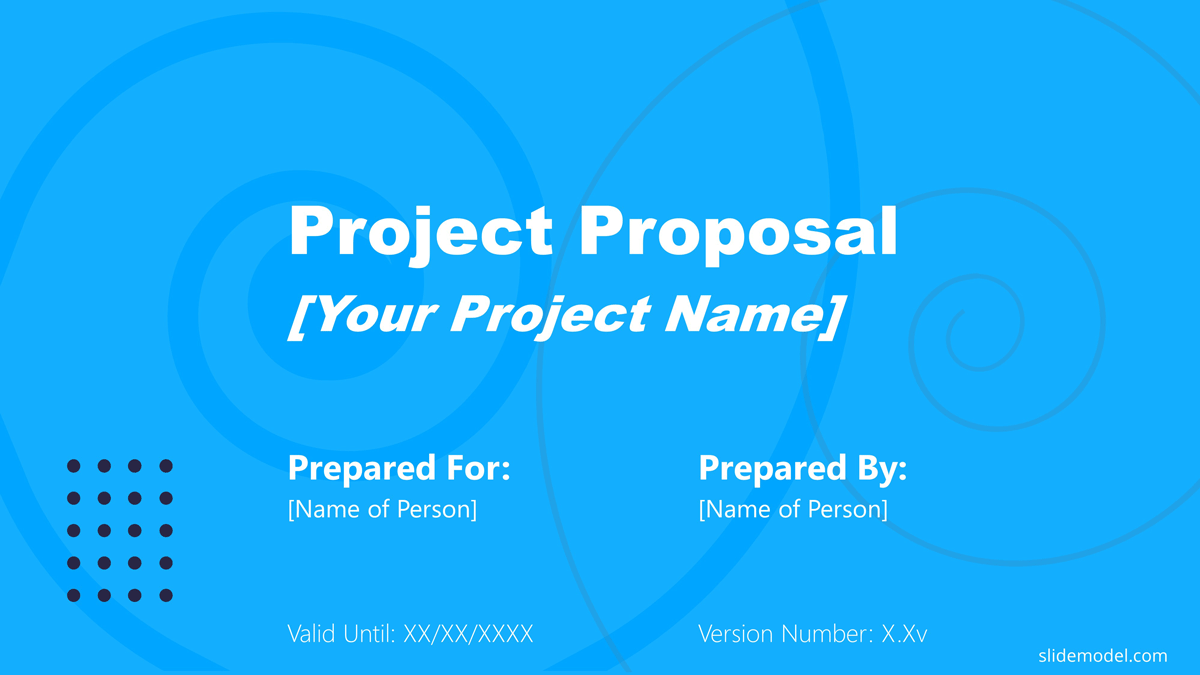
Slide 2: Table of Contents
Audience members will have an easier time paying attention if they know what to expect from your proposal presentation. See the following slide for a common project proposal table of contents format. When presenting it, do not dive into details. The agenda slide is aimed to set a mental state in the audience on the structure of the information will follow. It is a presentation best practice to prepare the audience.
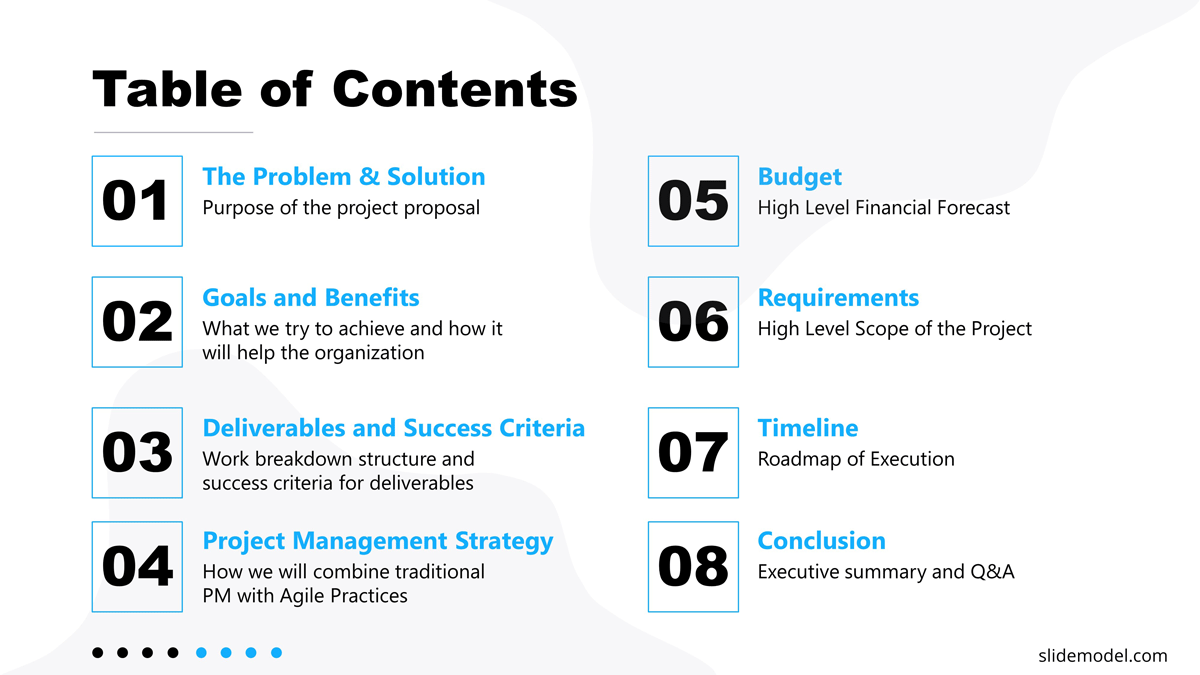
Slide 3: The Problem
Summarize your problem statement in one or two sentences. Be BOLD . When creating this problem summary, make sure to touch upon what the problem is, why it is a problem, how this problem manifests, who this problem affects, and what is the fallout of this problem. Make sure your message is directed to the real pain to solve. Avoid repeating the detailed problem definition; the audience can drill down in the documentation for the facts behind your statements.
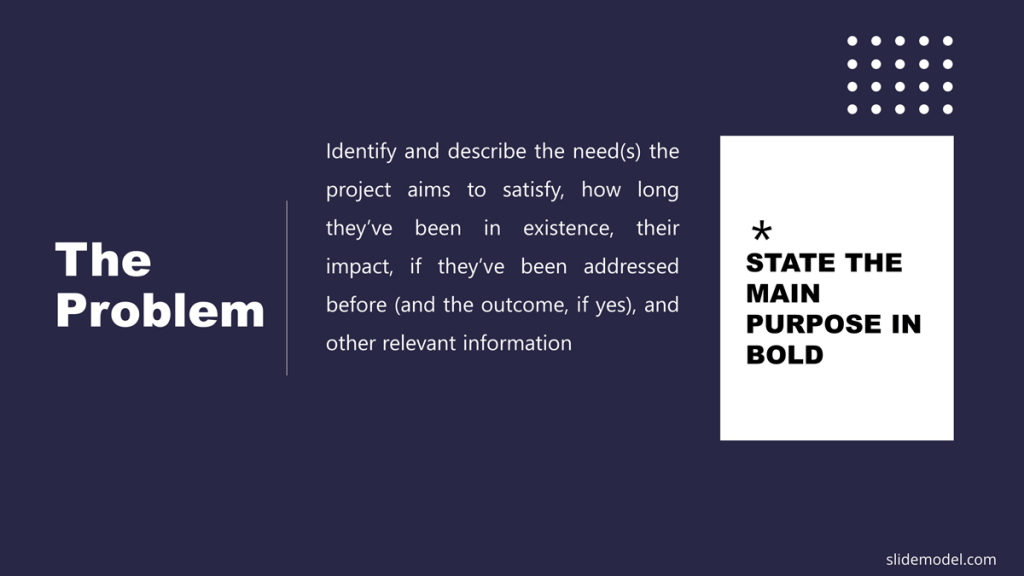
Slide 4: The Solution
As the first slide that formally introduces your projects proposal, this slide should briefly communicate what it is you are proposing to do. You can frame this slide in terms of the solution to the previously mentioned problem or you can introduce it as your plan. Either way, make sure this project introduction is no more than 1-3 sentences long. You’ll have time to specify other details in later slides. At this point of the presentation, your audience curiosity starts to peak, and you need to build your persuasive speech.
Slide 5: Goals and Benefits
For this slide, you want to briefly list the main goals for what you want to achieve with your project, as well as the top benefits your project will generate for the organization. While there may be a much larger list of these two components in your project proposal document, you’ll want to present the most important/relevant here. Try to group goals and benefits into categories. Remember that what you put on your PowerPoint slides is only the tip of the iceberg when it comes to your presentation. You can and should give more details in the spoken part of your proposal presentation.
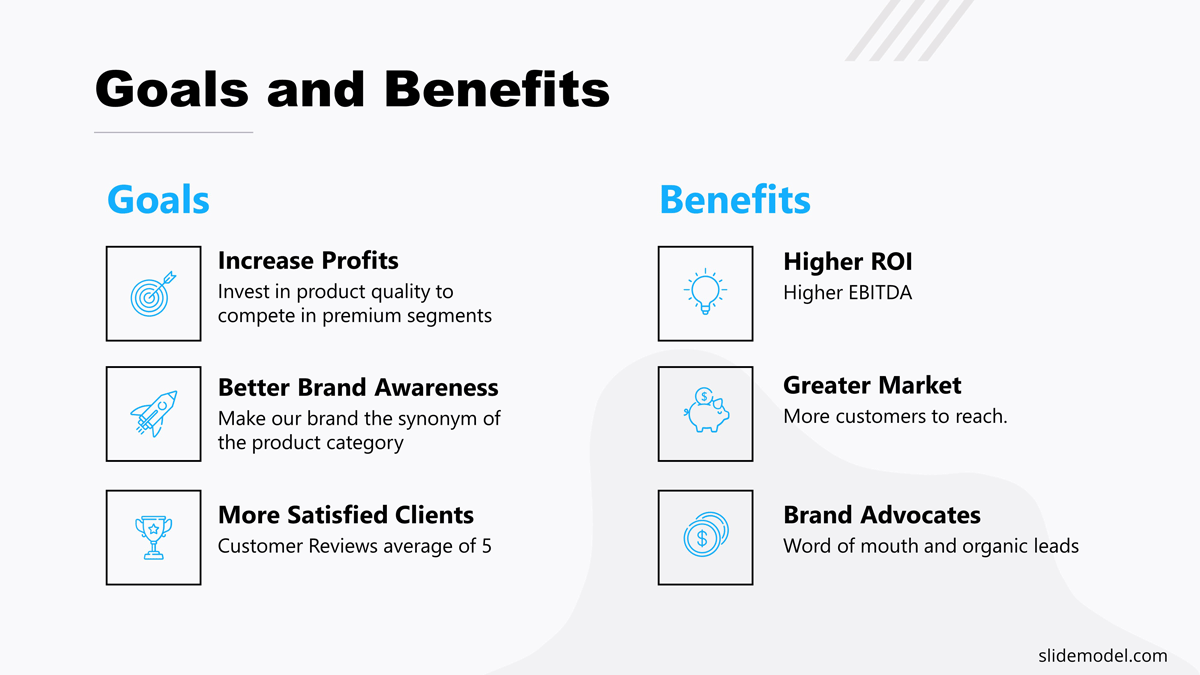
Slide 6: Deliverables and Success Criteria
Without going into too much detail, list deliverables, due dates, and criteria for acceptance for your main deliverables.
Slide 7: Project Management Strategy
State the project management strategy you’re planning to use to manage the project. You can’t assume everyone in your audience will understand what each project management strategy entails, so you should also provide a brief description of your choice. These templates detailing the Scrum , Kanban , and Waterfall methodologies can give you ideas of how to summarize your chosen methodology.
Slide 8: Budget
The budget slide remains pretty simple. Report both the total budget you anticipate for the project as well as a general breakdown of the budget into the main categories. Providing the percentage of each category of the budget is helpful for stakeholders to conceptualize it. In the Project Proposal Presentation template we have included a project budget slide (in slide #9) with a data table that can be used to present the Budget information.
Slide 9: Project Requirements
Other than budget, what’s needed in order to complete your project? Will you need human resources, specific software, equipment, or a special location in order to execute your project? Add a simplified list here of the main requirements.
Slide 10: Project Proposal Timeline
You will not be able to present the entire project timeline in a simple project proposal presentation. However, you should present an overview of the timeline, including major phases and deliverables. Instead of presenting a simple chart with deliverables and dates, we recommend placing your timeline of deliverables and phases in an actual calendar. This puts your timeline in a visual context of quarters, months, or weeks, allowing audience members to have a clearer concept of how long this project will take.
Slide 11: Conclusion
Close your project proposal with a very short summary of the project, similar to what you wrote previously when introducing your solution. The point of this is to remind your audience of the overarching reason for this presentation, especially after going over potentially less-than-inspiring details like budget and requirements.
Slide 12: Thank You Slide
Don’t forget to thank your audience for listening to your project proposal. Add your contact information in case this project proposal is sent over email and reviewed individually.
Final Words
In this article we had reviewed the definition of project proposal, its main structure and a guide on how to present it to your stakeholders. For further reading about presentations skills , here is a guide to improving your public speaking skills that will help you present your project proposal even more effectively. Hope you had enjoyed the reading.
Like this article? Please share
Project Execution, Project Management, Project Planning Filed under Business

Related Articles
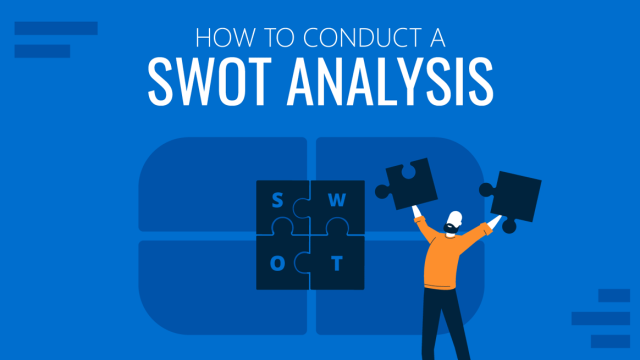
Filed under Business • August 14th, 2024
How to Conduct a SWOT Analysis (Examples + Templates)
Bring value to your business and to potential customers by learning how to conduct a SWOT analysis. Detailed guide with examples + suggested templates.
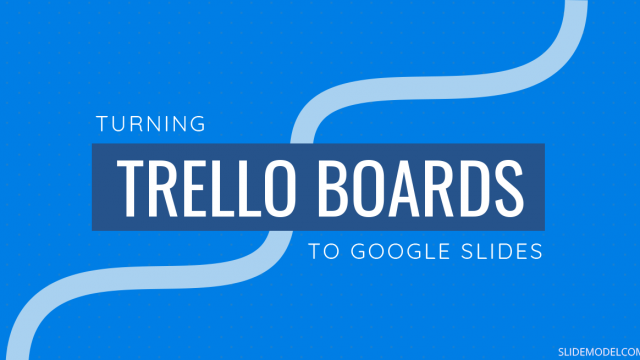
Filed under Google Slides Tutorials • July 15th, 2024
How to Export Trello Board to Google Slides
In this article you will learn how to export Trello Boards and convert them instantly into Google Slides, in a step by step tutorial.
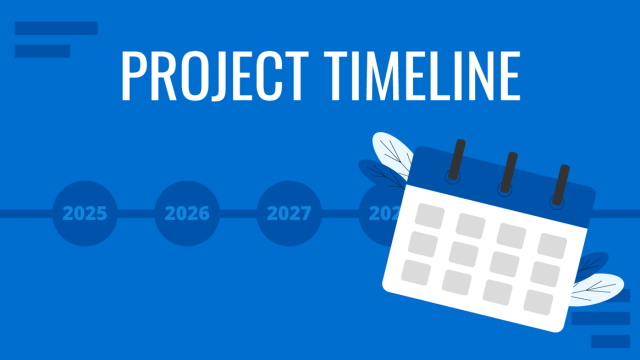
Filed under Business • April 24th, 2024
How to Create and Present a Project Timeline
Building a project timeline is an essential aspect of project management. Stay tuned to our detailed guide with examples and templates.
Leave a Reply
Make a Winning Business Proposal Presentation in 11 Steps
Learn how to create business proposal presentations that stand out and win deals. Apply battle-tested best practices and actionable tips from sales pros.
9 minute read

helped business professionals at:

Short answer
What makes a good business proposal presentation?
An outstanding business proposal presentation combines clarity, conciseness, and compelling storytelling.
It should be visually engaging, tailored to the audience's interests, and demonstrate a deep understanding of their needs, setting the stage for successful collaboration.
Your business proposal is your last chance to impress
Making a business proposal presentation is your money time at the end of a long, exhausting sales process with a prospective client. Losing your sale at this stage would be most painful.
It can be overwhelming when you realize how much is riding on this one proposal.
Sending out an ill-made business proposal puts you at risk of losing your client’s buy-in at the very last moment.
This situation is stressful for most people, but it doesn’t have to be. To make this process as stress-free as can be, I put together a guide on how to make a proposal presentation that will give you a leg up over your competitors.
Let's get started!
What does a business proposal presentation look like?
A business proposal presentation today goes beyond traditional slides filled with bullet points. It's a deck that blends text, compelling visuals, and even interactive elements like charts, graphs, and short videos.
This modern approach reflects how we engage with content in our digital age – visually and interactively.
Here's what a modern business proposal presentation looks like:
11 steps for making a winning business proposal presentation
Whether you’re selling products or services to prospective clients or pitching new ventures, business presentations are an everyday part of modern business.
Still, most business professionals don’t know how to do it right.
The reason why so many business proposal presentations fail is that not all elements of a successful business proposal presentation are in place. You can ensure your presentation impresses prospects every time by following the following best practices.
1) Do your research about the prospect
Before you set out to craft your business proposal presentation, you must conduct thorough research about the company you’re going to be pitching to.
Often, the difference between a knockout business presentation and a poor one is the level of confidence during the delivery. Carrying out a great deal of detailed research beforehand will give you the confidence needed to ace the presentation. Here's an example of how you can present your findings in a concise way:

The key pieces of information you need to get are:
What is the company size and sector?
What do their internal processes look like?
Who are the main decision-makers in the company?
Who are they selling their products and services to? Is it a B2B or B2C company?
What is your prospect’s most pressing problem?
What are they hoping to achieve?
What is your role in helping them reach these goals?
What is their allocated budget?
Have they ever used other industry solutions?
Finding the answers to these questions will ensure that your lead is qualified and allow you to bring up relevant insights during your presentation.
It will also make your prospect feel understood , which will capture their attention and boost your closing rate.
How to get information about your prospect
Making a discovery call
Visiting their website
Observing their social media accounts
Analyzing their competitors
B2B databases, such as G2 or Capterra
Data prospecting tools like ADD: Hunter , ZoomInfo or Lusha
2) Personalize your proposal presentation
If you do your homework right and know who your potential client is, you will be able to deliver a tailor-made business proposal presentation.
Our research shows that by personalizing your proposal, you’re increasing the number of people who will read your deck in full by 68% as compared to generic presentations.
If you think about it, it makes perfect sense. Every single email that starts with “Dear Owner” or “Dear User” immediately goes to live in my Bin folder.
By including a personal note tailored to your recipient, you’re skyrocketing the chances of it living rent-free in their head instead.
4 main ways to personalize your business proposal presentation:
I) Add company-specific insights
This can be anything you learned while doing your research on the prospect or something they mentioned during a discovery call.
II) Include your client’s name and logo in every business proposal presentation
If you’re using a PowerPoint this means going in and manually adding the identifying info into the deck.
If you’re using Storydoc, then this can easily be streamlined for scale using dynamic variables that change specific info for specific recipients.
This feature swaps out your client’s details while the rest of your deck stays intact, and with a 10-second setup, you’re good to go.
Here's how it works:

III) Include your prospect’s branding
If you’re using PowerPoint, then you’ll have to go in and change the design and visuals in your deck to fit your prospect’s branding. Alternatively, you can use a DIY tool like Snappa’s SVG editor or Logo.com’s logo generator .
With Storydoc, you can automatically apply branding pulled from any given website just by providing the website address—including the brand’s colors and fonts.
This will make an impact on your prospect while requiring minimal effort on your part, let alone involving a designer.

IV) Keep your proposal relevant at all times
When choosing client stories to share in your business proposal, stick to companies from a similar field.
Show a deep understanding of your prospect’s industry, key pain points, and competitors. This will make it easier for them to visualize what your solution can do for them.
3) Use a battle-tested presentation structure
It doesn’t matter if you’re in the last stage of your sales pipeline or still moving prospects down the funnel.
There are some common elements each business proposal presentation needs to have in order to perform exceptionally.
In our usage data we see presentations with similar business proposal structures outperform the rest time and time again.
What to include in a business proposal presentation
8 essential slides of a business proposal presentation:
1. Title page: This should include essential information such as your company's name, the client's name, and logo, along with the submission date.
2. Assessment or project overview: Here, clearly define the client's problem or need and outline your proposed solution. This section establishes the context and purpose of your proposal.
3. Executive summary: Offer a concise summary of your proposal, highlighting your unique value proposition. For tips on how to write one, read our 101 guide .
4. Methodology: The how to your what and why . In this part, you should explain the methods you’ll use to deliver on your promises and include a list of deliverables with a projected timetable.
5. Pricing: Provide a clear, transparent breakdown of costs for your services or products. Offering multiple pricing options can cater to different client needs or budgets.
6. Proof of qualifications: Showcase your credibility with evidence of past successes. Include case studies, testimonials, relevant certifications, and any industry awards you've received.
7. Team: Introduce the key team members who will be involved in the project. Highlight their skills and roles to build trust and confidence in your team's capabilities.
8. Next step: Conclude with a call-to-action detailing the next step a prospect is supposed to take after viewing your business proposal presentation.
4) Maximize your impact with a compact presentation
You may feel that the more information you include in your business proposal presentation, the higher your chances of sealing the deal are. But it’s the exact opposite.
The busier people get the narrower their attention spans. I can assure you that when faced with a bulky document, your prospects will either skim through it or not bother reading at all.
It’s more constructive to keep your presentation short and concise by including only the information most relevant to your prospect and with the biggest needed to finalize their decision to buy.
5) Avoid complex information and jargon
Complexity adds to cognitive load and any additional bit of information makes it harder to decide.
The best strategy for your business proposal would be to bring up only the most important aspects of your product or service that came up during the sales process.
You don’t have the time or attention to tell them everything. So tell them what really makes a difference.
Don’t get too technical
No matter how great the technology behind your solution is, I can assure you that most of your clients don’t care about the details. They care about the outcome your solution brings them, and what it’s going to cost them in time and money.
Sounds harsh? Sorry, but that’s the reality.
We don’t buy the latest iPhone because it has a pro 12MP camera system or a lens with a ƒ/1.8 aperture and 120° field of view. We buy it because we can take holiday photos for Instagram that will make Debra from HR green with envy.
Your customers are no different. They don’t need to have the same level of knowledge about your solution that you do. You will only confuse them by bombarding them with technical details.
Write in simple words and sentences
The extent of the attention your proposal will likely get is similar to that of an 8th grader. If you know your solution inside and out, you should be able to explain it simply.
Practice answering these questions as if asked by an 8th grader:
What does your company do and what makes you best qualified for the job?
What are your customers’ main pain points?
What is your proposed solution and how are you going to tackle the prospect’s problems?
What is the project timeline?
How much will it cost the prospect?
What are the gains for a prospect by choosing to work with you?
Who are the main team members that are going to work on this project?
What relevant experience do you have?
Refine your unique value proposition
Always remember that your ability to stand out is limited to your ability to deliver a simple and crisp value proposition. Simple is easy to understand and most importantly makes it easier to choose.
But there’s more! No matter what your business does, your biggest competitor is the status quo , where buyers choose to do nothing at all.
Seth Godin said in his seminal book This is Marketing that sales or marketing professionals are agents of change. But change takes time and effort. It’s easy for buyers to stick to what they have, even if it no longer serves them.
When talking about your product or service, don't just explain the benefits. Also show your clients what they might lose if they don't choose you, and explain the opportunity cost of doing nothing.
Here's a great video explaining how to write a UVP statement:
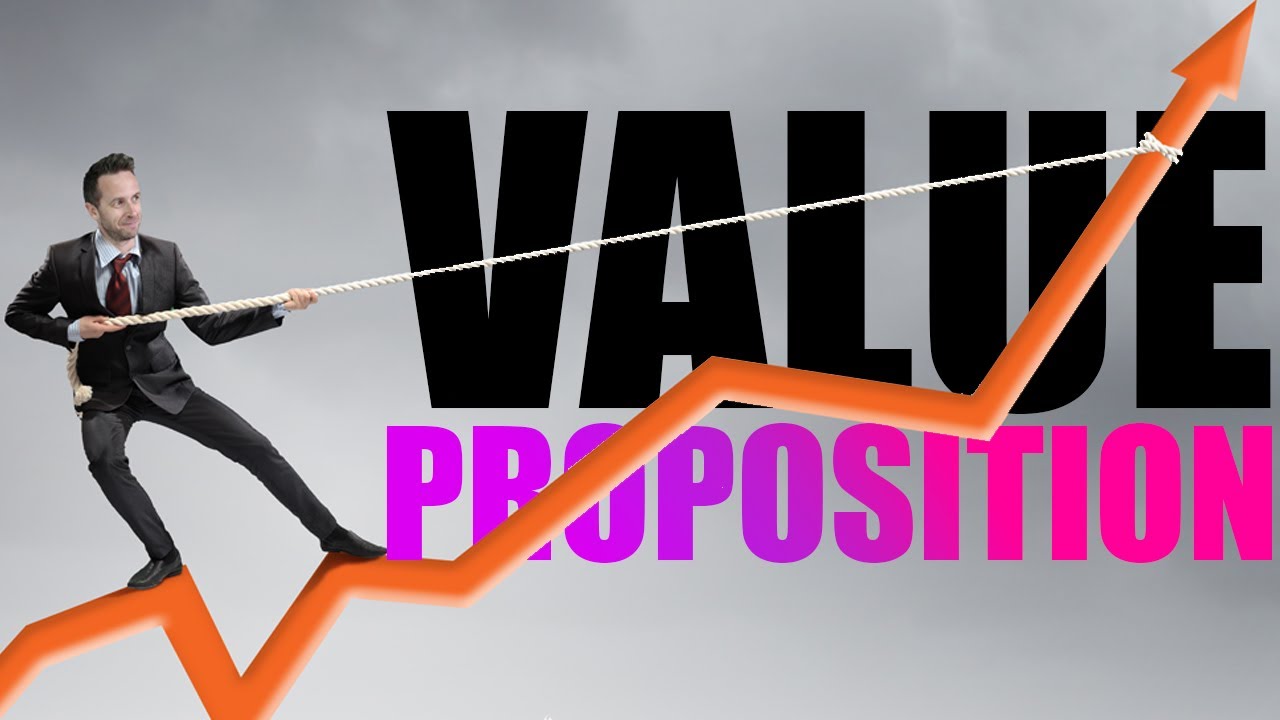
6) Provide social proof
At this point in the buyer’s journey, your lead should already trust you. If they didn’t, they would not proceed beyond the demo or even book a demo.
So why add social proof again at this late stage?
Well, big expenses make most people’s knees shake. Even if the money is not their own, they will be judged by their procurement (your solution) and the business impact it generates.
You need to have past clients vouch for you, to prove that it’s not your first rodeo and that your buyers can count on you to deliver.
Here are different types of social proof our clients used in their decks.
First up, a classic client testimonial:

Then, client logos with the Capterra rating:

And a mention in a reputable industry publication:
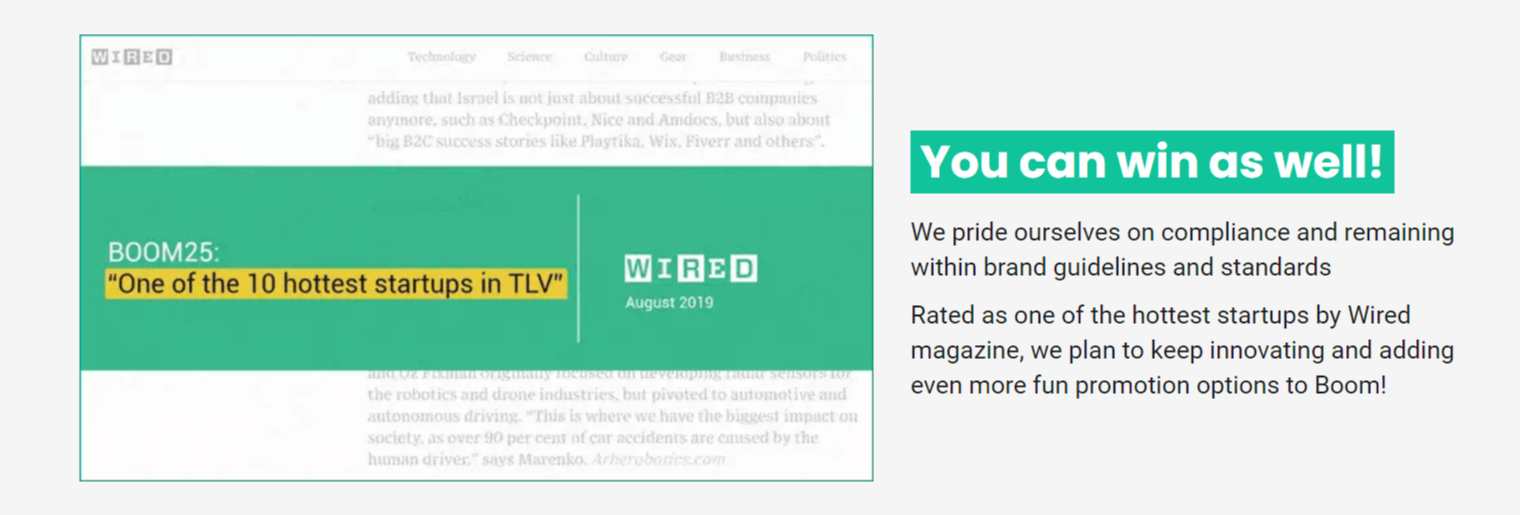
7) Include case studies
Case studies are the dark horse of the business race. They’re the least used asset in B2B because of how work-intensive their production is. But, at the same time, case studies are the most effective type of marketing asset .
By not including a case study in your business proposal, you’re running the risk of potential clients finding out about your solution from other sources. Worst case scenario, those other sources are your competitors. If you feature a case study, you’re in control of the narrative. You can basically have your clients sell for you by covering the main value propositions in their own words.
Here's a case study example from our client:

8) Position yourself as a consultant rather than a seller
It’s mostly true that people hate being sold to, but they love to buy.
Most buyers prefer to avoid meeting with salespeople and follow the self-serve route because they fear that salespeople will pressure or manipulate them into buying the wrong thing.
Sales are already losing big to self-service. A McKinsey survey from 2020 suggests that 70% of B2B buyers now look kindly on making self-serve buying decisions, even when considering solutions costing $500K and more.
But there is a way sales can always stay one step ahead of self-serve, and 10 steps ahead of the competition—shifting from being salesy to being consultative.
This means knowing the concerns and needs of your buyer and delivering the information they need to make an informed decision, even if it means (hope you're sitting down) not buying your product or solution because it’s not a good fit.
This approach was pioneered by Anthony Iannarino , and you can read more about How to be truly consultative on his website The Sales Blog.
9) Add videos to your business proposal
In this day and age, purely static content just won’t cut it anymore . If your slide contains walls of text, most people will skip it and move straight to the next part, or the next proposal.
Out of all visual aid types, videos are the most compelling. People get distracted very easily, so having a video that conveys the same message really helps keep them engaged.
Presentation statistics based on our extensive user data support the claim that video brings a positive impact —if you include a video in your cover slide, 32% more people will interact with your presentation.
The findings are even greater for other presentation sections.
By embedding *any* video in your presentation, you can increase the average reading time by 37% and increase the CTA click-through rate by 17% .
This proposal is a great example of effective video use:
10) Make the next step clear to your buyer
Including a clear call to action at the end of your business proposal presentation is crucial. As obvious as this must sound to some, many businesses fail to do this effectively.
If a prospective client reads the entire business proposal, they’re clearly interested in your value proposition. They may be ready to seal the deal.
The worst thing that can happen at this stage is if they don’t know how to proceed. It’s like building a supermarket without a checkout counter.
Here's an example of a smart CTA:

What's not an effective call to action?
A text that tells your buyer to give you a call
An email link for requesting the documents needed for signing
Or a phone number they need to dial.
An effective call to action can be:
Embedding a calendar to let prospects book the next meeting
The option to download key documents (e.g. an NDA or a contract)
Sending prospects to explore more details about your solution (e.g. try out your tool or look at examples from your portfolio)
Embedding a digital signature for buyers to sign directly in your deck
An embedded payment module for buyers to pay directly from your deck
Here's another great example of a deck with an effective CTA:

11) Move from legacy design to modern design
Most guides teach you how to make a business proposal using PowerPoint presentations. But, b y sending your business proposal presentation in PPT format, you’re giving leads something they’ve seen 1000 times over.
With sales closing rates declining for the past 5 years in a row, it’s a major risk to cling to the old ways.
When we analyzed over 100,000 sales and marketing presentations , we discovered that giving prospects presentations that can only be read majorly kills engagement.
If you want to succeed and grow your win rate you’ll have to move up to dynamic interactive proposal decks.
By giving readers interactive elements to “play around” with, you’re increasing the chances of your deck being read in full by 41% and the average reading time by 146% .
This is what static vs interactive looks like:
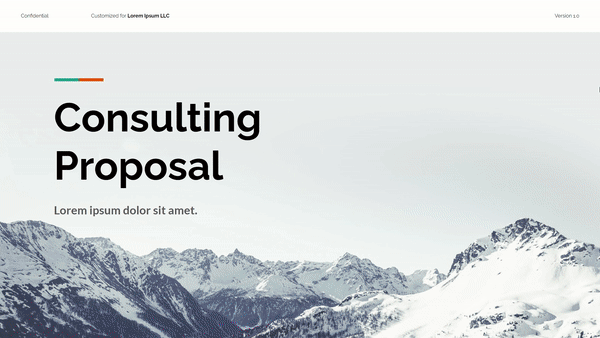
How to create a business proposal presentation faster than ever with AI
Tell the AI assistant what kind of proposal you'd like to create.
Provide an overview of your company and your product or service.
Choose your preferred template .
Adjust the design to reflect your or your prospect’s branding in just a few clicks.
Add videos and dynamic storytelling content.
Personalize your business proposals for the specific buyer.
Integrate your sales tools into the deck, like Calendly or DocuSign .
Send the deck and see the data stream in.
Analyze your usage data to get deep insights into your sales process.
Optimize your decks based on what works and what doesn’t work for your prospects.
Interactive business proposal templates
We all know that putting together a proposal can be tough. It's like the final lap in a race where you've got to give it your all.
Interactive business proposal templates are like a roadmap, guiding you on how to structure your proposal so it looks professional and hits all the right notes.
The best part is that they're built to engage. Instead of sending over a standard document, you're bringing your proposal to life with dynamic animations, informative videos, and interactive elements.
Grab a template and see how it can transform your deck.

Hi, I'm Dominika, Content Specialist at Storydoc. As a creative professional with experience in fashion, I'm here to show you how to amplify your brand message through the power of storytelling and eye-catching visuals.
Found this post useful?
Subscribe to our monthly newsletter.
Get notified as more awesome content goes live.
(No spam, no ads, opt-out whenever)
You've just joined an elite group of people that make the top performing 1% of sales and marketing collateral.

Create your best proposal to date
Stop losing opportunities to ineffective presentations. Your new amazing deck is one click away!
We use essential cookies to make Venngage work. By clicking “Accept All Cookies”, you agree to the storing of cookies on your device to enhance site navigation, analyze site usage, and assist in our marketing efforts.
Manage Cookies
Cookies and similar technologies collect certain information about how you’re using our website. Some of them are essential, and without them you wouldn’t be able to use Venngage. But others are optional, and you get to choose whether we use them or not.
Strictly Necessary Cookies
These cookies are always on, as they’re essential for making Venngage work, and making it safe. Without these cookies, services you’ve asked for can’t be provided.
Show cookie providers
- Google Login
Functionality Cookies
These cookies help us provide enhanced functionality and personalisation, and remember your settings. They may be set by us or by third party providers.
Performance Cookies
These cookies help us analyze how many people are using Venngage, where they come from and how they're using it. If you opt out of these cookies, we can’t get feedback to make Venngage better for you and all our users.
- Google Analytics
Targeting Cookies
These cookies are set by our advertising partners to track your activity and show you relevant Venngage ads on other sites as you browse the internet.
- Google Tag Manager
- Infographics
- Daily Infographics
- Popular Templates
- Accessibility
- Graphic Design
- Graphs and Charts
- Data Visualization
- Human Resources
- Beginner Guides
Blog Business How To Create A Winning Business Proposal Presentation
How To Create A Winning Business Proposal Presentation
Written by: Krystle Wong Jun 28, 2023

In the corporate landscape, a good business proposal presentation can be a game-changer to seal the deal with your prospective client or investors.
Think of your business proposal presentations as your chance to showcase your groundbreaking ideas, products or services to potential clients, investors and stakeholders. Whether you’re convincing investors to fund your dreams or clients to choose your services, creating a compelling presentation can make them go, “You know what? I’m sold!”
A good presentation simplifies the complex. It breaks down complicated concepts into bite-sized pieces that even those who are not in the industry can understand. I know I know, it’s no easy work and you’ve got enough on your plate — so let our selection of pitch deck templates take the load off the design work.
Customizing a compelling business proposal presentation takes only minutes thanks to Venngage’s user-friendly drag-and-drop editor. Just so you know, some of our presentation templates are free to use and some require a small monthly fee. Sign-up is always free, as is access to Venngage’s online drag-and-drop editor.
Now that you’ve got one less thing to worry about, let’s get back to business on how to create and deliver a winning proposal presentation.
Click to jump ahead:
What makes a good business proposal , 10 tips to create an effective business proposal presentation, 8 steps to deliver a winning business proposal presentation, create a business proposal presentation that will win over your clients with venngage.
If you’ve read our guide on how to write winning business proposals , you’ll know that a successful business proposal is one that answers the following questions:
- Who you are and what your company does
- The problem your buyer is facing
- The solution your company offers to alleviate the problem
- How your company will implement this solution effectively
- An estimate of resources (time, money, etc) required to implement the solution
Well, picture this: you’ve spent countless hours crafting a comprehensive business proposal that has the potential to revolutionize your industry. But here’s the catch – you need to condense all that information into a presentation that grabs attention, engages your audience and leaves a lasting impression.
It’s not easy, but it’s also not impossible. If you have an important proposal presentation coming up, I highly recommend you check out this guide on how to summarize information for presentations .
A good presentation gets things moving! Check out the top qualities of awesome presentations and learn all about how to make a good presentation to help you nail that captivating delivery.
Now, before we dive deep into the tips and tricks of creating and delivering a successful business proposal presentation, here are some business pitch examples to help you get inspired and win over new clients and investors. Alright, let’s get started!
Still working on your business proposal? Check out our selection of business proposal templates designed by our professional team.
In this competitive business environment, a good presentation gives you an edge over your competitors. It allows you to showcase your unique selling points, competitive advantages and differentiates you from others in the industry.
Whether it is securing a new client, securing funding or obtaining a favorable business agreement, a successful presentation can ultimately bring significant opportunities and long-term business growth.
Tip number one: always start with a solid presentation layout . Your presentation should emphasize the most important aspects of your business proposal, ensuring that they stand out and resonate with your audience. To do that, here are 10 tips along with some professionally crafted business proposal presentation templates to help you ace your next business proposal presentation.
1. Crafting a compelling storyline
A strong narrative structure is the backbone of any successful proposal presentation. Start with a captivating opening that grabs attention and clearly articulates the problem or opportunity at hand. Present your solution with confidence, providing solid evidence and data to support your claims. Finally, conclude with a powerful call to action that leaves your audience inspired and ready to take the next steps.
A timeline graph can help you organize your ideas as you create a compelling storyline for your presentation and make your content more engaging. Determine the important events or milestones that are relevant to your presentation topic. This will provide a sense of direction and structure for your storyline.

2. Focusing on the problem and solution
One of the keys to an effective business proposal presentation is highlighting the problem or challenge your audience is facing. Clearly communicate how your proposal provides a viable solution in bullet points, emphasizing the benefits and advantages it offers. Show your audience that you understand their pain points and present your proposal as the ideal answer to their needs.
This example of proposal presentation talked about the challenges that beginners face when going to the gym and how they provide the solution for it.

3. Using a consistent and professional template
To create a polished and cohesive visual experience, choose a clean and professional slide template that aligns with your brand colors. Consistency in design throughout the presentation not only enhances the overall look but also reinforces your professionalism and attention to detail.

Last-minute presentations are the worst, but don’t panic! Customize one of our professionally designed business presentation templates to save time and hassle.
4. engaging with visuals.
A picture is worth a thousand words and in the case of your proposal presentation, visuals can be your secret weapon. Visuals play a crucial role in capturing your audience’s attention and making complex information more digestible. Utilize charts, graphs, images and diagrams strategically to support your key points and reinforce your message.
As a business owner, a well-thought-out finance pitch deck provides a platform to outline the business’s strategic direction and growth plans. It allows you to highlight your unique value proposition, competitive positioning, marketing strategies and expansion plans. Here’s a template I figured you could use:

No idea what goes into your financial pitch deck? This guide on how to make successful pitch decks for start ups might help.
5. addressing potential objections.
Many business proposal presentations fail to anticipate potential objections or concerns audiences might have. Showing that you’ve considered challenges and providing persuasive counterarguments or solutions boosts your preparedness and increases the credibility of your proposal. Addressing objections head-on demonstrates your ability to handle potential hurdles and builds trust with your audience.
6. Using multimedia elements in your slides
To add depth and variety to your presentation, consider incorporating multimedia elements such as videos, audio clips, interactive charts or animations. These elements help illustrate concepts, showcase product demonstrations or provide real-life examples, making your proposal more engaging and memorable.

7. Incorporating interactive elements
Depending on the platform or setting of your presentation, incorporating interactive elements can enhance engagement. Live polls, Q&A sessions or group exercises encourage active participation, clarification and a deeper understanding of your proposal. Creating opportunities for interaction keeps your audience engaged and invested in the presentation.
8. Testing the readability and accessibility of your slides
Ensure that your slides are easily readable on different devices and screen sizes. Test for color blindness accessibility by using tools or viewing your presentation in grayscale. Consider incorporating alt text for images to make your presentation accessible to visually impaired individuals. Ensuring readability and accessibility demonstrates your commitment to inclusivity and professionalism.

Sometimes, using a simple presentation template makes all the difference as they promote effective communication, minimizes confusion and ensures that the audience can grasp the main points effortlessly. Try it out for your next presentation!
9. practice, practice and practice again.
Even the most well-prepared presentation can fall flat if you stumble through it. So, practice, practice and practice some more. Rehearse your presentation until you feel comfortable and confident. Pay attention to your tone, pace and body language. Incorporate pauses for emphasis, maintain eye contact and engage with your audience. I promise — the more you practice, the more comfortable and effective you’ll become as a presenter.
10. Ending with a memorable closing statement
Leave a lasting impression by crafting a memorable closing statement. Summarize the key benefits of your proposal, reinforce its importance or leave your audience with a thought-provoking quote. End your presentation with a call to action that inspires action and demonstrates the urgency of taking the next steps.

Ready to get started? Pick from these engaging presentation templates that can get your audience hooked on your presentation till the end.
Your business proposal presentation can be the key to securing new clients, partnerships or investment opportunities. That said, delivering a winning presentation requires careful planning, effective communication and a deep understanding of your audience’s needs.
Follow these 8 essential steps to deliver a persuasive and impactful business proposal presentation:
Step 1: Understand the requirements
Before diving into your business proposal presentation, take the time to clearly understand the requirements. Familiarize yourself with the format, time limit, submission date and any specific guidelines provided by the audience or client. This ensures that you meet their expectations and deliver a presentation that aligns with their needs.
Step 2: Research your audience
To make a lasting impact, conduct thorough research on your audience. Gain insights into their industry, needs, challenges and goals. This information allows you to tailor your presentation to their specific interests, speak their language and demonstrate the relevance of your proposal. It will also help you show that you understand their pain points and present your solution as the perfect fit for their requirements.
For example, this business proposal presentation targets food entrepreneurs and manufacturers who are passionate about the plant-based lifestyle to attract franchisees for their local green ingredients franchise.

Step 3: Plan your content
A well-organized presentation keeps your audience engaged and makes your proposal more compelling. Develop a clear and logical structure to help strengthen your message and deliver a winning business proposal presentation. Define the key points you want to convey and outline the flow of information and make sure your content effectively addresses the audience’s pain points and emphasizes the benefits of your proposal.
The opening moments of your presentation hold immense power – check out these 15 ways to start a presentation to set the stage and captivate your audience.
Step 4: Create compelling slides
Design visually appealing slides that support your content and enhance its impact. Use a consistent template that aligns with your branding and maintains a professional look. Incorporate high-quality visuals such as relevant images, charts or graphs to convey information effectively.
Creativity is important but keep the design clean, uncluttered and focused on conveying your message clearly. Remember, visually engaging slides capture attention and reinforce your professionalism.

Don’t know where to start? Here are 5 ways how you can design winner presentation slides . Or you could browse our library of creative presentation templates that’ll easily set your presentation apart from competitors.
Step 5: engage your audience.
Active audience engagement is key to a successful business proposal presentation. Encourage interaction throughout your presentation by asking thought-provoking questions, seeking input or incorporating interactive elements like polls or group exercises. Show genuine interest in your audience’s feedback and questions as this builds rapport and demonstrates that you value their perspective. Engaging your audience creates a dynamic and memorable experience.
Giving an online presentation? Here are some tips on how to adapt your in-person presentation into a virtual presentation that will leave a lasting impression.
Step 6: communicate with clarity.
Focus on the key messages and benefits of your proposal. Clear communication is vital to conveying your ideas effectively, so be sure to use language that is easily understandable and free from jargon. Support your points with concrete examples or stories that resonate with your audience. By communicating with clarity, you ensure that your message is easily comprehensible and memorable.

Step 7: Adapt and respond
Flexibility is crucial when delivering a business proposal presentation. Pay close attention to your audience’s reactions, questions and feedback. Be prepared to adapt your presentation on the fly to address their specific needs and concerns.
The trick is to listen attentively and respond thoughtfully, demonstrating your ability to cater to their requirements. This flexibility and responsiveness build trust and show that you genuinely care about meeting their expectations.
Step 8: Follow up
After concluding your presentation, don’t let the momentum fade away. Follow up with your audience to address any remaining questions, provide additional information or clarify any points.
Following up with your audience helps maintain the relationship and keeps the conversation going. By staying in touch, you demonstrate your commitment to their success and increase the chances of moving forward with your proposal.
Have another round of presentations coming up? Give it your best with these tips on how to improve your presentation skills .
A business proposal presentation is not just a chance to present your business idea; it’s a prime opportunity to showcase the unique value, potential and profitability of your business concept
By following the tips and tricks in this article, I’m confident that business professionals like you can easily win over potential investors and prospective clients.
Venngage offers a wide range of pre-designed templates specifically tailored for business proposals. With the help of Venngage’s presentation maker , creating visually appealing and professional business proposal presentations becomes easier than ever.
Step 1: Sign up for a Venngage account (P.S. It’s free!).
Step 2: Browse through Venngage’s template library and choose a business presentation template that suits your needs (they’re all created by our expert in-house designers).
Step 3: Replace the placeholder text in the template with content from your business proposals.
Step 4: Customize your business presentation in just a few clicks with our user-friendly drag-and-drop editor tool. Modify various elements such as text, colors, fonts, backgrounds and layout. Enhance your presentation with visual aids such as images, icons, charts and graphs.
Step 5: Share your presentation publicly or upgrade to a business account to export the presentation to PowerPoint or PDF. You can also choose to present straight from Venngage’s presentation software.
Discover popular designs

Infographic maker

Brochure maker

White paper online

Newsletter creator

Flyer maker

Timeline maker

Letterhead maker

Mind map maker

Ebook maker

COMMENTS
A business proposal presentation is a document that outlines a business solution for a customer after a lengthy consultation process. It is presented to the customer in either PDF or PowerPoint format, and can be paired with a contract for immediate signing.
Formal project proposals have clear sections that have been proven to effectively communicate a project idea. The basics include context about the problem or pain trying to solve, a high level action plan, and the required resources to execute it.
Make a Winning Business Proposal Presentation in 11 Steps. Learn how to create business proposal presentations that stand out and win deals. Apply battle-tested best practices and actionable tips from sales pros.
Make your next business proposal presentation a success with these 15 tips. No matter how great your idea is, it all boils down to how you present it. Get the practical and simple design tricks to take your slides from “meh” to “stunning”!
Create a winning business proposal presentation and elevate your presentation skills with this comprehensive guide.
If you want to know how to make a business proposal presentation that captivates your audience, we've got you covered. Here's a guide with tips and inspiration to craft the perfect proposal presentation.